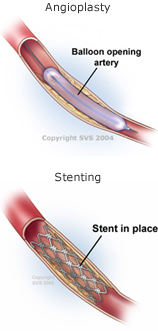PATIENT INFORMATION
Endovascular and Bypass Surgery for Occlusive Disease
Procedure Instructions
Endovascular Procedures
Angioplasty and stenting are endovascular procedures that may be used to repair a severely narrowed artery or a short blockage. Both can be done through a small puncture, usually at the groin. As a result, general anesthesia isn’t needed, so recovery can be much quicker and complications fewer than with open bypass surgery.
Before the Endovascular Procedure
The procedures may take 30 minutes to several hours. You may be required to stay overnight in the hospital. Arrange for someone to drive you home.
Although you can be awake during the procedure, you will receive a local anesthetic to numb your skin at site of the puncture. You will be given fluids and medications to help you relax through an IV. 
The doctor may ask you to refrain from eating or drinking after midnight on the day of your procedure, although you may be asked to take certain of your medications with a sip of water on the morning of your procedure. Be sure you inform your doctor of all medications you take.
Angioplasty uses a tiny balloon to open blocked arteries. The balloon is inflated and deflated several times to press the plaque against the artery wall. Once the artery has been unblocked, the balloon is deflated and removed. Blood can flow freely through the widened artery.
Stenting is the insertion of a tiny wire mesh tube into an artery to hold it open. The collapsed stent is mounted onto a balloon catheter and guided across the blockage. The balloon is inflated to open the stent, which locks into place inside the artery. The balloon is deflated and removed, leaving the stent in place, holding the artery open.
After the Endovascular Procedure
For either procedure, you will lay flat after the procedure and may be asked not to bend your leg for 2 to 6 hours. During this time the blood flow in your legs will be closely monitored by nurses who will check your pulses and skin color and temperature. You’ll likely go home within hours of your procedure, although some patients spend the night in the hospital. Expect to have some swelling and bruising around the puncture site at the groin, and possibly spreading across your thigh and abdomen. This is normal.
Risks and complications of this procedure include rupture of the treated artery, bleeding, blood clots, heart or lung complications, and kidney problems.
When to Call the Doctor
- Bleeding at the catheter insertion (puncture) site.
- Excessive swelling.
- Chest pain or trouble breathing.
- A fever of 101.5 degrees or higher.
- A foot that gets cold to touch or turns a mottled/purple color.
You are always welcome to call the office with your questions or concerns. After hours, an answering service will direct your questions to the on-call providers. However, these individuals are unable to call in prescriptions for pain medication after 5 p.m.
BYPASS SURGERY
Procedure Preparation
Bypass surgery may be the only option for longer or more severe blockages in the abdominal aorta. Bypass surgery involves using a graft to create a new pathway for blood around the blockage. The graft will be a synthetic tube that acts like an artery, carrying blood to the arteries that supply blood to your groin and legs.
Risks and Complications
It is important to be aware of the risks and complications before any surgical procedure. The risks and complications for bypass surgery include: bleeding, infection, numbness or pain around the incisions, risks from anesthesia, and blood clots.
Preparing for Surgery
- Tell your doctor about all medications you are taking, including vitamins, supplements, and blood thinners.
- Do not eat or drink anything after midnight the night before your surgery.
- Make sure that you have someone to drive you home from the hospital when you are discharged, usually in 3 to 8 days.
During the Operation
You will be put to sleep by the anesthesiologist before the procedure begins. To reach the blockage, the surgeon makes a large incision along the abdomen and incisions at each groin. A synthetic artery is then sewn into the artery above and below the blocked section. Once blood flows freely through the graft, the surgeon closes the incision with sutures or staples. The blocked section of artery is usually not removed.
Recovering from Surgery
- You will recover in the hospital for 3 to 8 days after surgery, depending on the type of bypass you have, your health, and your response to surgery. Full recovery may require a month or more.
- After surgery you will be monitored closely in the recovery room, and from there you may go to an intensive care unit or to a regular hospital room. Your abdomen and groin will swell and be painful, but your doctor will prescribe pain medications to control the pain.
- You will start to walk soon after surgery. Typically, on the day after surgery you will get out of bed to sit in a chair. About 48 hours after surgery your nurse or physical therapist will assist you in getting out of bed and walking. Walking is very important after surgery. Walking helps to reduce swelling, speeds healing, and helps prevent lung problems such as pneumonia. The sooner you are up and walking, the sooner you can go home.
- Elevate your leg whenever you are sitting to help minimize swelling.
- Tell a nurse right away if you have chest pain, foot pain, or shortness of breath.
Constipation is very common following a surgery. The anesthetic used during the operation paralyzes the bowel, which can lead to constipation for up to a week. Pain medications such as Vicodin or Percocet also cause the bowel to move more slowly. You may try over-the-counter medications such as milk of magnesia, Colace, or Metamucil, as well as prune or apple juice to get your bowels moving.
Pain is common after surgery, especially around an incision site. The pain medication prescribed by your doctor will help with this pain, which should improve in the days following your surgery. Check with your doctor before using ibuprofen in addition to the prescribed pain medication, but do not take it if you have ulcers, kidney problems, or you are allergic to ibuprofen.
Fever: Your temperature can vary after surgery and a low-grade temperature is common. If your temperature exceeds 101.5 degrees or if it is accompanied by chills, vomiting, or flu-like symptoms, the doctor should be notified.
Incision: Your incisions will be covered by a sterile bandage or steri-strip, which will fall off in time on its own. Report any drainage from your incision. The drainage should be thin, watery, and slightly pink, but should not be bright red blood. An infection may be starting if the drainage is thick green or yellow, or if the skin around the incision is red or warm to touch. Some swelling and bruising around the incisions is normal and should improve in the days following your surgery.
When to Call the Doctor
- Fever over 101.5 degrees.
- Increased redness or drainage from an incision.
- Nausea or vomiting.
- Increasing pain in the toes or foot, they have changed color, or you can’t move them.
- Difficulty breathing.
When to Go the Emergency Room
- Uncontrolled bleeding from the incisions.
- Persistent vomiting.
- Change in mental status.
- Inability to breathe.
You are always welcome to call the office with your questions or concerns. After hours, an answering service will direct your questions to the on-call providers. However, these individuals are unable to call in prescriptions for pain medication after 5 p.m.
